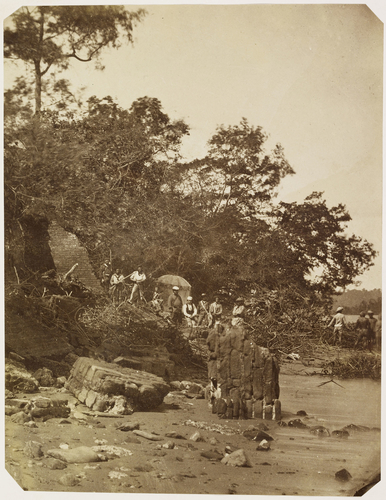From the end of the eighteenth century up to the early 1860s, the East India Company transported c. 25,000 convicts to penal settlements across Southeast Asia. Most came from British India (including Burma), with smaller numbers from the Crown Colony of Sri Lanka. The earliest destinations were Bencoolen and the Andaman Islands, followed by Penang, Malacca, and Singapore, and finally Burma. Outside the region, a few convicts were also sent to the port of Aden and the island of Mauritius. A small number of these convicts were rebels and political offenders, whilst the majority had been convicted of ordinary criminal offences. They were put to labour on public works projects and made a major contribution to infrastructural development, plantation agriculture and other industries.

The thrust of these transportations varied over time, and only where and when the Company desired the permanent occupation of new territories and frontiers did it transport convict women. This was because it saw the creation of families as a means of establishing long-term settlement. Further, because the cost of a return passage was not paid, after serving their sentences, most convicts stayed in these penal destinations. Only tiny numbers of women were transported, and although they married male convicts, otherwise ex-convicts had relationships with and blended into other local and migrant populations. In Mauritius, these included Indian indentured labourers, and in Penang and Malacca the Malay-speaking Muslims of mixed ancestry known as Jawi Peranakan (or Pekan).
There must be numerous convict descendants in these historic penal settlement locations today, but currently these are largely acknowledged. The important work of architectural historian Anoma Pieris has noted the efforts of local historians to retrieve the histories of ordinary convicts in Singapore. She highlights the reticence of individuals to acknowledge their heritage, arguing that convict histories are mainly acknowledged where connections can be made between their punishment and transportation and broader nationalist struggles.

An excellent example of this is the case of Bhai Maharaj Singh, a “Saint Soldier” who was sent to Singapore in 1850. He was lodged separately from the other convicts, and a British commissioner at the time wrote that prison guards in Singapore bowed down before him, whilst hundreds of “devotees” came to worship him. “The Guru is not an ordinary man,” he wrote. “He is to the Natives what Jesus Christ is to the most zealous of Christians.” Bhai Maharaj Singh died in 1856, and the Sikh community in Singapore today remember and celebrate him as both as a spiritual leader and as a hero of Sikh nationalism. (There are no known descendants).

Matters are quite different in Sri Lanka and Malaysia. Anoma Pieris has written that in the latter case people are “quick to venture convict ancestry in families other than their own”. In contrast, in the former, the descendants of Sri Lankan convict Tikiri Banda Dunuwille (Dunuwila), who live on the island today, acknowledge and celebrate their heritage. Tikiri Banda was the son of a royal minister and had been transported for treason following the Kandyan Rebellion of 1848. He served his sentence in Malacca, then returned home (apparently with his Chinese family) where he married twice, had four children, and died in 1898.
When writing my PhD on the Indian penal settlement of Mauritius in the mid-1990s I tried unsuccessfully to locate convict descendants on the island. A few of them had children, and so they must exist. For sure, they have blended into the general population, joining South Asian-descended or Creole populations. The same is true of the former penal settlement site of Penang. The archives contain lists of marriages and children between ex-convicts, dating from the 1870s, and newspapers indicate the death of the last surviving convict in the first decade of the twentieth century. However, descendants have not yet been identified.
Finally, whilst the late eighteenth-century penal settlement in the Andamans was abandoned due to high mortality rates, a penal colony was established in the Islands after the Great Revolt of 1857-8. This occupation had a devastating impact on the Indigenous populations living there.

Today numerous descendants of convicts – calling themselves the “local born” – live in the Islands. The experiences and identities of these peoples are part of this project and will be the focus of a future blog.
Further reading (open access)
- Anoma Pieris (2011), ‘The “Other” Side of Labor Reform: Accounts of Incarceration and Resistance in the Straits Settlements Penal System, 1825-1873’, Journal of Social History, 45, 2, (2011), 453-479.
- Clare Anderson (2010) The Transportation of Narain Singh: Punishment, Honour and Identity from the Anglo-Sikh Wars to the Great Revolt, Modern Asian Studies, 44 (5), 1115-45.
- (2019) Convicts, Commodities, and Connections in British Asia and the Indian Ocean, 1789-1866, International Review of Social History, 64 (S27), 205-27.
- (2018) The British Indian Empire, 1789-1939, in Clare Anderson, ed., A Global History of Convicts and Penal Colonies (London), 211-44.
- (2016) A Global History of Exile in Asia, c. 1700-1900, in Ronit Ricci, ed., Exile in Colonial Asia: Kings, Convicts, Commemoration (Honolulu, University of Hawai‘i Press), 37-79.
- (2005) The Bel Ombre Rebellion: Indian convicts in Mauritius, 1815-53, in Gwyn Campbell, ed., Abolition and its Aftermath in Indian Ocean Africa and Asia (London, Routledge), 50-65.